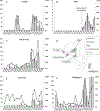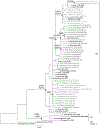Spatiotemporal circulation of influenza viruses in 5 African countries during 2008-2009: a collaborative study of the Institut Pasteur International Network
- PMID: 23169972
- PMCID: PMC8250070
- DOI: 10.1093/infdis/jis541
Spatiotemporal circulation of influenza viruses in 5 African countries during 2008-2009: a collaborative study of the Institut Pasteur International Network
Abstract
Background: Although recent work has described the spatiotemporal diffusion of influenza viruses worldwide, comprehensive data on spatiotemporal patterns of influenza from the African continent and Madagascar are still lacking.
Methods: National Influenza Centers from 5 countries-Cameroon, Côte d'Ivoire, Madagascar, Niger, and Senegal--collected specimens from patients presenting with influenza-like illness who visited sentinel surveillance clinics during a 2-year period (2008-2009). Isolates were genetically and antigenically characterized.
Results: Overall, 8312 specimens were tested. Seasonal influenza A virus subtypes H1N1 and H3N2 and influenza B viruses were detected in 329, 689, and 148 specimens, respectively. In 2009, pandemic influenza A virus subtype H1N1 was detected in Madagascar most commonly (98.5% of cases). Influenza activity was either significant year-round or occurred during a specific period of the year in the African countries we evaluated.
Conclusions: Our results demonstrate that, from Madagascar to Senegal, the epidemiologic and virologic characteristics of influenza viruses are diverse in terms of spatiotemporal circulation of the different virus types, subtypes, and strains. Our data highlight the importance of country-specific surveillance and of data and virus sharing, and they provide a rational basis to aid policy makers to develop strategies, such as vaccination at the right moment and with the right formulation, aimed at reducing the disease burden in Africa and Madagascar.
Conflict of interest statement
All authors have submitted the ICMJE Form for Disclosure of Potential Conflicts of Interest. Conflicts that the editors consider relevant to the content of the manuscript have been disclosed.
Figures


Similar articles
-
[Influenza surveillance in five consecutive seasons during post pandemic period: results from National Influenza Center, Turkey].Mikrobiyol Bul. 2016 Jul;50(3):401-17. doi: 10.5578/mb.27775. Mikrobiyol Bul. 2016. PMID: 27525396 Turkish.
-
Genetic characterization of human influenza viruses in the pandemic (2009-2010) and post-pandemic (2010-2011) periods in Japan.PLoS One. 2012;7(6):e36455. doi: 10.1371/journal.pone.0036455. Epub 2012 Jun 27. PLoS One. 2012. PMID: 22761651 Free PMC article.
-
Influenza seasonality in Madagascar: the mysterious African free-runner.Influenza Other Respir Viruses. 2015 May;9(3):101-9. doi: 10.1111/irv.12308. Influenza Other Respir Viruses. 2015. PMID: 25711873 Free PMC article.
-
[Swine influenza virus: evolution mechanism and epidemic characterization--a review].Wei Sheng Wu Xue Bao. 2009 Sep;49(9):1138-45. Wei Sheng Wu Xue Bao. 2009. PMID: 20030049 Review. Chinese.
-
Recent zoonoses caused by influenza A viruses.Rev Sci Tech. 2000 Apr;19(1):197-225. doi: 10.20506/rst.19.1.1220. Rev Sci Tech. 2000. PMID: 11189716 Review.
Cited by
-
Clinical and epidemiological characterization of influenza virus infections in children with severe acute respiratory infection in Maputo, Mozambique: Results from the implementation of sentinel surveillance, 2014 - 2016.PLoS One. 2018 Mar 28;13(3):e0194138. doi: 10.1371/journal.pone.0194138. eCollection 2018. PLoS One. 2018. PMID: 29590162 Free PMC article.
-
Viral co-infection with human respiratory syncytial virus in suspected acute and severe respiratory tract infections during COVID-19 pandemic in Yaoundé, Cameroon, 2020-2021.Influenza Other Respir Viruses. 2023 Mar;17(3):e13131. doi: 10.1111/irv.13131. Influenza Other Respir Viruses. 2023. PMID: 36991539 Free PMC article.
-
Both hemispheric influenza vaccine recommendations would have missed near half of the circulating viruses in Madagascar.Influenza Other Respir Viruses. 2017 Nov;11(6):473-478. doi: 10.1111/irv.12517. Influenza Other Respir Viruses. 2017. PMID: 29067783 Free PMC article.
-
Epidemiology and molecular characterization of influenza viruses in Burkina Faso, sub-Saharan Africa.Influenza Other Respir Viruses. 2018 Jul;12(4):490-496. doi: 10.1111/irv.12539. Epub 2018 Apr 24. Influenza Other Respir Viruses. 2018. PMID: 29350841 Free PMC article.
-
Multiyear persistence of 2 pandemic A/H1N1 influenza virus lineages in West Africa.J Infect Dis. 2014 Jul 1;210(1):121-5. doi: 10.1093/infdis/jiu047. Epub 2014 Jan 19. J Infect Dis. 2014. PMID: 24446525 Free PMC article.
References
-
- Pan American Health Organization (PAHO). Final report of the XVI Meeting on vaccine preventable-disease of the pan American health organization. Washington, District of Columbia: PAHO, 2004. http://www.paho.org/English/AD/FCH/IM/TAG16_FinalReport_2004.pdf. Accessed 25 April 2011.
-
- World Health Organization. Acute respiratory infections in children. Geneva: WHO, 2010. http://www.who.int/fch/depts/cah/resp_infections/en/print.html. Accessed 25 April 2011.
-
- Williams BG, Gouws E, Boschi-Pinto C, Bryce J, Dye C. Estimates of world-wide distribution of child deaths from acute respiratory infections. Lancet Infect Dis 2002; 2:25–32. - PubMed
-
- Murray CJ, Lopez AD. Mortality by cause for eight regions of the world: global burden of disease study. Lancet 1997; 349:1269–76. - PubMed
-
- Schnell D, Mayaux J, de Bazelaire C, et al. Risk factors for pneumonia in immunocompromised patients with influenza. Respir Med 2010; 104:1050–6. - PubMed
Publication types
MeSH terms
Substances
Grants and funding
LinkOut - more resources
Full Text Sources
Medical

